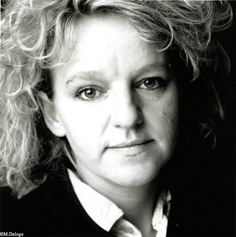|
Soloist music (except voice) Vocal music a cappella Chamber music Instrumental and symphonic music Vocal and instruments music Vidéo-opéra List of works List of works by date |
 |
|---|
score | listen | editor Date : 2002 Duration : 15 mn Commission : CIRM for le Festival Manca 2002, Nice Editor : Editions Jobert Nomenclature : for 2 male voices (ténor and deep bass), ensemble : flûte, clarinet, horn, trombone, viola, cello and electroacoustic live. Text: written by Marcello Fois for Florence Baschet Dédicated : to François Paris Premiere : le 8 november 2002 at Festival MANCA in Nice, Eglise Saint-François de Paule Soloists : ténor, Adrian Brand ans bass, Fabrice Chomienne, ensemble L’Itinéraire, direction Olivier Cuendet. Assistant musical Carl Faia. Reprises : Ircam, 20 janvier 2003, direction P.A. Valade, L’Itinéraire, ténor Adrian Brand et basse, Bertrand Bontoux, assistant musical Serge Lemouton, Festival MIA le 8 novemvre 2003 à Annecy avec les mêmes solistes et l’ensemble « La Pleiade » d’Annecy, dir. JP Odiau, technique Ircam. Festival Why Note novembre 2004 à Dijon, par l’ensemble L’Itinéraire, dir. P.A.Valade, technique Ircam. Notice: Filastrocca focuses on the vocal material Sardinian singers of the 'Confrérie de Castelsardo'. Exceptional traditional music that can be defined as a "harmonic resonance in singing." The men of the village of Castelsardo practiced for generations this vocal technique of oral tradition and perpetuated through the sacred repertoire. They sing a capella, in quartet vocal formation. With their vocal technique, they are able to create the emergence of a fifth pitch understood as a fifth voice called "Quintina". Voice of woman we today call "virtual". Hearing this secular music, I wanted to write Filastrocca and try to define the link between archaism and modernity, a close link I wanted to seal as alliances and sound alloys between the fifteenth century Sardinian vocal and my contemporaneity. On one hand, these Sardinian vocal techniques practiced for centuries that reveal an intuitive knowledge certainly, but perfectly accurate sound properties of the voice; on the other hand, in recent decades, our advanced technology on the physical properties and formant of voice (scientific research with computers, algorithms and software) which enabled us to make huge progress in analysis, simulation and transformation of these properties. So it seemed to me interesting to measure the proximity / distance between two musical worlds and assemble them into one and only musical project: a piece for two male voices, instrumental ensemble and live electronics. So I went to Sardinia in Castelsardo where I met the singers of the 'Confraternita' I registered in choir and separately (bassu - contra - bogi and falsettu). It is these "samples" sound you hear in the piece, in their original form and transformed, the vocal material of Castelsardo voices being omnipresent in Filastrocca. The Italian author Marcello Fois wrote at my request the text of the piece, a poem in Sardinian language that gives the work its musical form of "jingle", hence the title of Filastrocca, "one who file the words ". With thanks to Mr Bernard Lortat Jacob, CNRS researcher, ethnomusicologist and author of 'Chants de passion' for Editions du Cerf 1998. With thanks to the singers of the Confraternity of Castelsardo. Copyright florence Baschet. Résidence : Filastrocca' has been written during my residence in Chateau de la Napoule, Cannes. Electroacoustic setup - Dispositif électroacoustique en temps réel, par synthèse granulaire, choeur virtuel (PSOLA) et calcul des spectres formantiques. - Système Max / MaxMSP-Ircam / pédale midi pour le chef / Console de diffusion. - Assistant musical : (Cirm) Carl Faïa et (Ircam) Serge Lemouton. - Amplification des 2 voix (micros HF) et des 6 instruments. - Il est prévu une diffusion du matériel sonore électroacoustique sur 8 haut-parleurs placés en cercle autour du public. - Il est conseillé de jouer la pièce dans un espace réverbérant, ou, à défaut, de simuler la réverbération de l’espace de concert. Florence Baschet |
|---|